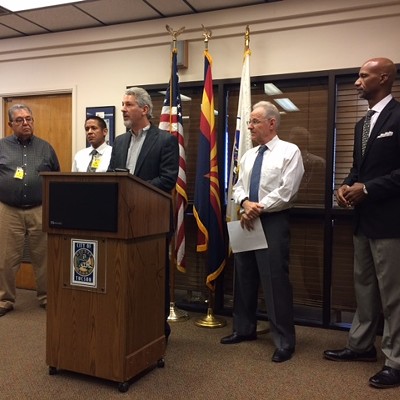Still, it began as a puzzle. "So, how can you build a house on Euclid where you can have any kind of creature comfort?" asks Bodie Robins, a professional home designer. "It's admittedly a horrible home site."
Then the couple answered their own question with this hushed, 2,000-square-foot model of energy efficiency, where 18-inch rammed-earth walls blunt both noise and temperature spikes; the Robins' utility bills average around $40 each month.
This weekend, their exceptionally designed home is among 20 featured on the Tucson Innovative Home Tour 2005: New Ways to Be at Home in the Desert. Co-sponsored by the Solar Institute, and now celebrating its 10th year, the tour is notable for what it avoids: During two days of open houses, you will not be exploring profligate and self-indulgent McMansions. Instead, this outing applauds the cleverly diminished footprint. "It's not about beautiful homes and aesthetics, although you'll certainly find them," says Paul Huddy, the institute's director. "It's about the practical and cost-effective--about things that work.
"The people on this tour are modern pioneers," he says. "They've been trying new things they felt would make their homes better. And Tucson is recognized around the world as being in the forefront of conservation efficiency."
Timing couldn't be better, given rising fuel costs, and alternative-energy tax breaks in an otherwise noxious energy bill recently passed by Congress. While that legislation's major beneficiaries are electric utilities, gas companies and oil drillers, it does offer up to $500 in tax credits for energy-efficient furnaces, air conditioners and insulation.
That's not much, but it is a start. Coupled with long-term savings on utility costs--expected only to rise in coming years--energy efficient homes are more alluring all the time, says Huddy. "We're on the edge of a shifting energy paradigm, away from fossil fuels. And recent polls show that people really support new alternative energy solutions."
It's easy to figure why. Consider this: Each year, metro Tucson uses more than $1 billion worth of energy, equal to about 10 percent of our gross local product. Or this: The energy costs of "green" homes are often 75 percent less than traditional houses.
You'll see plenty of green examples on the tour, ranging from new building systems and very sophisticated insulation to homes expertly situated for effective use of sunlight and shade. There's a straw bale B&B; the nature-friendly "dream home" of a local artist; a "green" charter school; Solar Haven, built for less than $35 per square-foot--and glowingly independent of the power grid; the cutting-edge homes of top solar engineers; and four award-winning eco-communities.
There's also the home from one leading builder where a small pump provides all heating and cooling, and the energy system is 100 percent solar. Total price tag? Less than $100,000.
While Tucson is a leader in this rapidly evolving field, the shift is decidedly national; in 2004 alone, more than 14,000 green homes were constructed across the country. Marking this movement, the National Association of Home Builders holds annual "green building" conferences, and recently issued comprehensive guidelines for conservation-minded contractors. "We're seeing a huge trend, driven by builder interest and consumer demand," says John Loyer, a code specialist for the association's green building department in Washington, D.C.
Loyer calls it a "holistic approach to building and energy efficiency." But going green doesn't require wads of green: The new NAHB guidelines "allow builders to change their techniques without building a more expensive product," he says. "It can be done extremely cost-effectively, and have a payback well within the first seven to 10 years."
Still, certain economic factors--namely the all-powerful fossil fuel industry--have hampered the advance of alternatives in home energy designs, says Huddy. "But the public is absolutely ready to embrace alternatives. Every poll that's been taken for the last three decades indicate that."
The old energy order won't die without a fight, however. Consider that the United States annually uses roughly 98 quadrillion BTUs of energy, and oil comprises about 40 percent of that. Natural gas and coal make up roughly 23 percent, and 8 percent comes from nuclear. Only a tiny 5 percent comes from renewable energy such as solar.
Broken down, energy from local utility companies currently costs about eight or nine cents per kilowatt hour, while solar energy costs around 25 cents respectively. That's a big gap. And according to analysts, solar won't become attractive to the mainstream public until it drops under 20 cents per hour.
But analysts don't know everything, and cost isn't the only driver behind any alternative building boom. There's also the matter of social responsibility in the face of global warming, international politics and the dangerous stranglehold of big oil. That's why change is needed now more than ever, Huddy says. "And we need change that really has to do with energy, the economy and our society."
And to corrupt a cliché, change begins one home at a time. Just ask the Robins. Back on Euclid Avenue, they've already seen a payback by keeping their utility bill measly--and by filling a noisy city corner rather than adding to endless urban sprawl.












